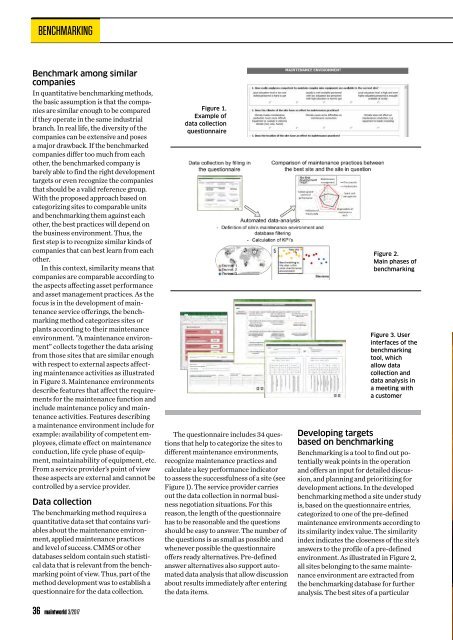Maintworld 3/2017
In this issue: Using Technology and Innovation to Manage Mega-Maintenance Challenges Identify the Root Cause of a Misalignment Condition Elements of a Good Preventive Maintenance Program
In this issue:
Using Technology and Innovation to Manage Mega-Maintenance Challenges
Identify the Root Cause of a Misalignment Condition
Elements of a Good Preventive Maintenance Program
You also want an ePaper? Increase the reach of your titles
YUMPU automatically turns print PDFs into web optimized ePapers that Google loves.
BENCHMARKING<br />
Benchmark among similar<br />
companies<br />
In quantitative benchmarking methods,<br />
the basic assumption is that the companies<br />
are similar enough to be compared<br />
if they operate in the same industrial<br />
branch. In real life, the diversity of the<br />
companies can be extensive and poses<br />
a major drawback. If the benchmarked<br />
companies differ too much from each<br />
other, the benchmarked company is<br />
barely able to find the right development<br />
targets or even recognize the companies<br />
that should be a valid reference group.<br />
With the proposed approach based on<br />
categorizing sites to comparable units<br />
and benchmarking them against each<br />
other, the best practices will depend on<br />
the business environment. Thus, the<br />
first step is to recognize similar kinds of<br />
companies that can best learn from each<br />
other.<br />
In this context, similarity means that<br />
companies are comparable according to<br />
the aspects affecting asset performance<br />
and asset management practices. As the<br />
focus is in the development of maintenance<br />
service offerings, the benchmarking<br />
method categorizes sites or<br />
plants according to their maintenance<br />
environment. ”A maintenance environment”<br />
collects together the data arising<br />
from those sites that are similar enough<br />
with respect to external aspects affecting<br />
maintenance activities as illustrated<br />
in Figure 3. Maintenance environments<br />
describe features that affect the requirements<br />
for the maintenance function and<br />
include maintenance policy and maintenance<br />
activities. Features describing<br />
a maintenance environment include for<br />
example: availability of competent employees,<br />
climate effect on maintenance<br />
conduction, life cycle phase of equipment,<br />
maintainability of equipment, etc.<br />
From a service provider’s point of view<br />
these aspects are external and cannot be<br />
controlled by a service provider.<br />
Data collection<br />
The benchmarking method requires a<br />
quantitative data set that contains variables<br />
about the maintenance environment,<br />
applied maintenance practices<br />
and level of success. CMMS or other<br />
databases seldom contain such statistical<br />
data that is relevant from the benchmarking<br />
point of view. Thus, part of the<br />
method development was to establish a<br />
questionnaire for the data collection.<br />
Figure 1.<br />
Example of<br />
data collection<br />
questionnaire<br />
The questionnaire includes 34 questions<br />
that help to categorize the sites to<br />
different maintenance environments,<br />
recognize maintenance practices and<br />
calculate a key performance indicator<br />
to assess the successfulness of a site (see<br />
Figure 1). The service provider carries<br />
out the data collection in normal business<br />
negotiation situations. For this<br />
reason, the length of the questionnaire<br />
has to be reasonable and the questions<br />
should be easy to answer. The number of<br />
the questions is as small as possible and<br />
whenever possible the questionnaire<br />
offers ready alternatives. Pre-defined<br />
answer alternatives also support automated<br />
data analysis that allow discussion<br />
about results immediately after entering<br />
the data items.<br />
Figure 2.<br />
Main phases of<br />
benchmarking<br />
Figure 3. User<br />
interfaces of the<br />
benchmarking<br />
tool, which<br />
allow data<br />
collection and<br />
data analysis in<br />
a meeting with<br />
a customer<br />
Developing targets<br />
based on benchmarking<br />
Benchmarking is a tool to find out potentially<br />
weak points in the operation<br />
and offers an input for detailed discussion,<br />
and planning and prioritizing for<br />
development actions. In the developed<br />
benchmarking method a site under study<br />
is, based on the questionnaire entries,<br />
categorized to one of the pre-defined<br />
maintenance environments according to<br />
its similarity index value. The similarity<br />
index indicates the closeness of the site’s<br />
answers to the profile of a pre-defined<br />
environment. As illustrated in Figure 2,<br />
all sites belonging to the same maintenance<br />
environment are extracted from<br />
the benchmarking database for further<br />
analysis. The best sites of a particular<br />
36 maintworld 3/<strong>2017</strong>

















